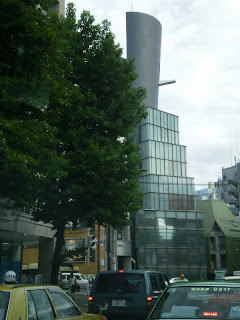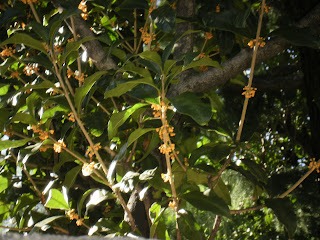Over the past 20 years I have been to Kyoto countless times. But yesterday I saw an entirely new side of the city. Literally. I always associate Kyoto with its carefully laid out gardens and temple precincts or the cross-hatched street grid comprising its central core. This time I went to the far reaches of its northern edge to visit two, rural hamlets, Miyama and Koshihata, that are parts of the city physically but not in spirit.
The purpose of my trip was to see two textile artists, one an expert in
aizome dying, and the other a master weaver who works with wool (yes!), silk and
kasuri dying, albeit rendered with a paint brush and artificial, chemical tints. Both bed down in idyllic settings but the scenery en route left an equally indelible impression on me.
Though traveling by car was the only way to go, the very thought of the drive makes me queasy -- my stomach definitely has a memory of its own. Due to the curving, mountain roads, I was practically in a constant state of nausea. I tried to distract myself by gazing out at the orderly rows of
Kitayamasugi (cedar) trees. Covering the sloping ground planes, the slender, many meter-high trees are leaf-free, except for plumes of greenery on top, the only parts to see the sun on a regular basis. Because of the trees’ density, only a few rays filter down through the thick forest, resulting in a mysterious, shadowy landscape accented with stripes of sunshine.


My efforts and
gaman were rewarded by views of the charming cluster of thatch-roofed houses nestled among the hills of Miyama. This small community still belongs to the farming families who live in its 250-year-old timber houses with their
Kitayamagata irimoya roofs built to shelter trays of silk worms above and humans plus their livestock below. Made of thick thatch, the roofs are bedecked with bright green moss on their northern faces while their sun-kissed, southern exposures remain a lovely golden brown.


In between the houses were neatly planted rows of sweet potatoes, tomatoes, eggplants and other vegetables. I even spied
awa, a rice substitute once eaten by impoverished rice growers who could not afford to consume their own produce. Today the grain has become so scarce that it is now a very expensive delicacy!
We then hopped back in the car and took a single-lane
kokudo (national road), barely wide enough for our sedan, through the mountains to visit the master weaver. He lives in an old
minka farmhouse, beautifully appointed with antique tools and carefully chosen furniture. The big table and chairs in his farm kitchen are clearly the heart of the house.
A short drive away, his studio occupies a converted greenhouse. He needs plenty of daylight to get the dye colors just right. Yesterday he had a series of wool skeins dyed in a spectrum of colors that were hanging out to dry. But the most spectacular sight was the
obi he is weaving – the silk warp threads stretch the entire length of the room! Before he weaves in the weft, the artist paints the silk by hand with an array of autumnal colors. He is preparing for a show at an Aoyama kimono shop in November. I am eager to see the finished product.

 Tonight is Halloween. Abby is going to be a flapper and Eve is going to be grass. You know, the stuff that lawns are made of. Getting Abby's costume together was not too challenging -- mostly this required combing our collective closets for appropriate garments. It helped greatly that I had the perfect dress and that Abby already had a navy wool cloche. Our only purchase was a long string of pinkish pearls. Fortunately Outlet in Hiroo came through for us.
Tonight is Halloween. Abby is going to be a flapper and Eve is going to be grass. You know, the stuff that lawns are made of. Getting Abby's costume together was not too challenging -- mostly this required combing our collective closets for appropriate garments. It helped greatly that I had the perfect dress and that Abby already had a navy wool cloche. Our only purchase was a long string of pinkish pearls. Fortunately Outlet in Hiroo came through for us.



















